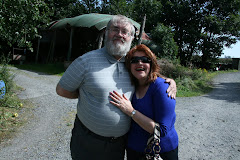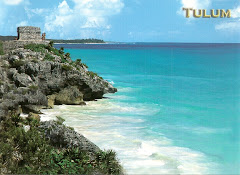After a week in Antigua Guatemala, we made our way to the airport to catch our plane to Cancun. The traffic was extremely slow due to an enormous traffic jam. Once in the airport, we boarded a small propellor airplane and we made a stop over in the island of Flores, the capital of Peten province. Really beautiful. From the air you could see the clear crystal turquoise waters and the next thing we knew, was that we were in Cancun, where you can get either a taxi for 50 dollars or a mini-bus for 28 dollars to wherever you have your accomodation. Once at our hotel, where all the staff from our previous visits were still working, they greeted us and were very happy to see us and welcomed us back. We were given a really nice room. The view from the balcony was spectacular. It was a real joy to see the the sun rise every morning, as well as to watch from the beach side of the hotel, the wonderful sunsets every day.
The next day, we went to Xcaret, a unique nature park which has everything. It was the brain-child of a wealthy architect who wanted to build his dream home beside the turquoise waters of the Maya riviera, but upon stumbling on so many unique and special features on his estate, like Maya ruins, an old mine, cenotes ( which are places where the limestone has collapsed leaving swimming pools from underground rivers ) rare flora and fauna, he thought this was just too much to keep it just for himself and he wanted to share all this wonder with other people. So he asked his two brothers to join him in the venture of creating a mixture of a park, a resort and also a place of learning for all ages. To go to Xcaret there is no dress code, you can go there dressed just with your swimming suit, a towel and your flip-flops if you like, or how you feel more comfortable. We had gone there before in previous trips but the place is so huge, that it is impossible to see it all in just one day. So this time we headed towards the other parts we had not had a chance to see before and what a treat it was. We had not seen the marine side to it. We saw gigantic turtles swim in the aqua waters at different stages of their development until they are old enough to be released into the sea, which is done at night. We saw all kinds of algaes, sharks, rays, sea horses, star fish and fish of all colours: electric blue, yellow ones with black stripes, mottled ones, red, golden etc.
Before that, we had lunch at one of their restaurants which was like a huge hut that had an enormous buffet with so much to choose from, that you really wish you had two tummies to be able to eat everything that is on offer. We also enjoyed seeing the pumas in their natural environment, as well as the spider monkeys, deer. Also, they have an area where they keep and breed butterflies. That is really like the kingdom of butterflies: you go in through the mouth of a cave into a tiny canyon open to the sky but with netting over it to keep the butterflies inside. The first thing you see, is a water fall with tropical plants and the giant light- blue butterflies like fairies flying with their waffer thin delicate wings, they are not shy to humans, as they land on your shoulders or your head it was unreal and very beautiful.
Wednesday, 11 February 2009
Saturday, 7 February 2009
January in Guatemala
What a change from walking in the balmy sunshine every day in Guatemala, also known as The City of Eternal Spring because the weather is just perfect. Not too hot, nor too cold and it has flowers all year round.
In Antigua Guatemala, the ancient capital, we stayed at a hotel called El Convento. It was recently renovated and they had kept all of its original walls, plus it had two patios a big one in the middle, plus another one on the side, with a small fountain. It was tastefully done without losing the character and feel of an ancient monument, the rooms had names instead of numbers. We stayed at the " ermita " room which had a small interior patio inside it, this sweet patio, had a small stone fountain encrusted in the ancient wall, the water flowed from the mouth of a lion, similar in size and shape to the lions you see in door knobs.
The shower room, had floors with beige flag-stones and on one side of it, it had the original wall whilst on the other, it had crystal clear glass, this elongated shower-room had a high ceiling with a sky-light roof, plus huge shelves at the back, made out of beige flag-stones, so when you walked inside it, it felt like if you were having a shower in the middle of the rain-forest.
The doors were all hand-carved. Each door had a different motif and so distinctive. It was refreshing not having to remember your room number. Out of the room, in the small patio, there was an iron spiral stair-case which led to the roof terrace and when you reached the top, you are greeted with spectacular views to the volcanos and blue skies. There was white day bed with comfy cushions to relax on, plus sofas and round tables and chairs. On Sunday, they had a buffet breakfast up on the roof terrace. It was a day to remember, the food was exquisite and the attention was such, that it did not seem like a buffet but a la carte menu; since once you had made your choice, the waiter would bring back your plate to your table. It was a perfect temperature and soft music was playing in the background. It felt like a dream.
The next day, we visited the Cathedral. This cathedral is only one third of what it used to be, since the terrible earthquakes brought down most of these huge thick walls and even though the walls were strong, they did not have the iron support needed to hold down the structure, so the walls and ceilings came crashing to where they have stood ever since. There is another colonial church which originally had 40 steps, now you can only see two steps, the rest were buried in the incandescent lava that became solidified. Also buried across from this church was the house which once belonged to Don Diego de Alvarado the Spanish conquistador of Guatemala whose wife died buried by the lava, along with all her ladies in waiting.
In Antigua Guatemala, the ancient capital, we stayed at a hotel called El Convento. It was recently renovated and they had kept all of its original walls, plus it had two patios a big one in the middle, plus another one on the side, with a small fountain. It was tastefully done without losing the character and feel of an ancient monument, the rooms had names instead of numbers. We stayed at the " ermita " room which had a small interior patio inside it, this sweet patio, had a small stone fountain encrusted in the ancient wall, the water flowed from the mouth of a lion, similar in size and shape to the lions you see in door knobs.
The shower room, had floors with beige flag-stones and on one side of it, it had the original wall whilst on the other, it had crystal clear glass, this elongated shower-room had a high ceiling with a sky-light roof, plus huge shelves at the back, made out of beige flag-stones, so when you walked inside it, it felt like if you were having a shower in the middle of the rain-forest.
The doors were all hand-carved. Each door had a different motif and so distinctive. It was refreshing not having to remember your room number. Out of the room, in the small patio, there was an iron spiral stair-case which led to the roof terrace and when you reached the top, you are greeted with spectacular views to the volcanos and blue skies. There was white day bed with comfy cushions to relax on, plus sofas and round tables and chairs. On Sunday, they had a buffet breakfast up on the roof terrace. It was a day to remember, the food was exquisite and the attention was such, that it did not seem like a buffet but a la carte menu; since once you had made your choice, the waiter would bring back your plate to your table. It was a perfect temperature and soft music was playing in the background. It felt like a dream.
The next day, we visited the Cathedral. This cathedral is only one third of what it used to be, since the terrible earthquakes brought down most of these huge thick walls and even though the walls were strong, they did not have the iron support needed to hold down the structure, so the walls and ceilings came crashing to where they have stood ever since. There is another colonial church which originally had 40 steps, now you can only see two steps, the rest were buried in the incandescent lava that became solidified. Also buried across from this church was the house which once belonged to Don Diego de Alvarado the Spanish conquistador of Guatemala whose wife died buried by the lava, along with all her ladies in waiting.
Wednesday, 4 February 2009
January in Mexico
Every holiday has magic moments. One of those moments was, when we were flying south-west of Mexico City. As I was looking through the window into a clear and unusually blue sky, not grey with smog, I could not believe what I was seeing at and excitedly I said to Peter: Look, look, look ! because very suddenly, right there, to my great delight and excitement, in perfect view we could see before us : Iztalccihuatl and Popocatepetl. Iztalccihuatl, is also known as " The Sleeping woman " because it has the uncanny resemblance of a woman lying on her back, over the top of a mountain. You can see her head, her long hair stretching downwards, her neck, the arms crossed over her chest, the legs, knees and feet as though she has a sheet over her body, running down through the side of the mountain.
There is a most popular legend about Iztaccihuatl and Popocatepetl, that comes from the ancient Nahuas, and there are also poems and songs telling this beautiful story which I will narrate as best as I can.
Many years before Hernan Cortez came to Mexico, the Aztecs lived in Tenochtitlan, today's Mexico City. The Chief of the Aztecs was a famous emperor, who was loved by all his people. The Emperor and his wife, the Empress, were very worried because they had no children. One day, the Empress told the Emperor that she was going to give birth to a child. A baby girl was born and she was as beautiful as her mother. They called her Iztaccihuatl which in Nahuatl means " White Lady "
All the people loved Izta and her parents prepared her to be the Empress of the Aztecs. When she grew up, she fell in love with a captain of a tribe; his name was Popoca. One day a war broke out and the warriors had to go south to fight the enemy. The emperor told Popoca to cut off the head of the enemy chief and bring it back from the war to show his victory. Then Popoca could marry the Emperor's daughter. After several months of combat, a warrior who hated Popoca sent a false message to the emperor. The message said that his army had won the war, but that Popoca had died in battle. The emperor was very sad when he heard the news and when Izta heard it, she could not stop crying. She refused to go out and did not eat anymore. A few days later, she became ill and she died of sadness.
When the Emperor was preparing Izta's funeral, Popoca and his warriors arrived victorious from war. The Emperor was taken aback when he saw Popoca, and he told him that other warriors had announced his death. Then he told him that Izta had died. Popoca was very sad. He took Izta's body and left the town with his warriors. He walked a long way, until he arrived at some mountains where he ordered his warriors to build a funeral table with flowers and he put Izta lying on top. Then he kneeled down holding a fiery torch to watch over Izta until he died of sadness too.
The Gods were touched by Popoca's sacrifice and turned the tables and the bodies into great volcanoes. The biggest volcano is the Popocatepetl which in Nanuatl means: " smoking mountain"; he sometimes throws out smoke showing that he is still watching over Iztaccihuatl who sleeps by his side. Popoca's torch is still smoking as a reminder of what happened.
There is a most popular legend about Iztaccihuatl and Popocatepetl, that comes from the ancient Nahuas, and there are also poems and songs telling this beautiful story which I will narrate as best as I can.
Many years before Hernan Cortez came to Mexico, the Aztecs lived in Tenochtitlan, today's Mexico City. The Chief of the Aztecs was a famous emperor, who was loved by all his people. The Emperor and his wife, the Empress, were very worried because they had no children. One day, the Empress told the Emperor that she was going to give birth to a child. A baby girl was born and she was as beautiful as her mother. They called her Iztaccihuatl which in Nahuatl means " White Lady "
All the people loved Izta and her parents prepared her to be the Empress of the Aztecs. When she grew up, she fell in love with a captain of a tribe; his name was Popoca. One day a war broke out and the warriors had to go south to fight the enemy. The emperor told Popoca to cut off the head of the enemy chief and bring it back from the war to show his victory. Then Popoca could marry the Emperor's daughter. After several months of combat, a warrior who hated Popoca sent a false message to the emperor. The message said that his army had won the war, but that Popoca had died in battle. The emperor was very sad when he heard the news and when Izta heard it, she could not stop crying. She refused to go out and did not eat anymore. A few days later, she became ill and she died of sadness.
When the Emperor was preparing Izta's funeral, Popoca and his warriors arrived victorious from war. The Emperor was taken aback when he saw Popoca, and he told him that other warriors had announced his death. Then he told him that Izta had died. Popoca was very sad. He took Izta's body and left the town with his warriors. He walked a long way, until he arrived at some mountains where he ordered his warriors to build a funeral table with flowers and he put Izta lying on top. Then he kneeled down holding a fiery torch to watch over Izta until he died of sadness too.
The Gods were touched by Popoca's sacrifice and turned the tables and the bodies into great volcanoes. The biggest volcano is the Popocatepetl which in Nanuatl means: " smoking mountain"; he sometimes throws out smoke showing that he is still watching over Iztaccihuatl who sleeps by his side. Popoca's torch is still smoking as a reminder of what happened.
Subscribe to:
Comments (Atom)
































































.jpg)
.jpg)









































